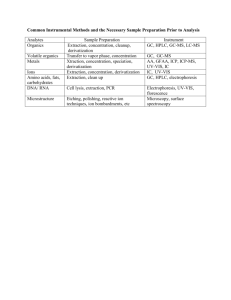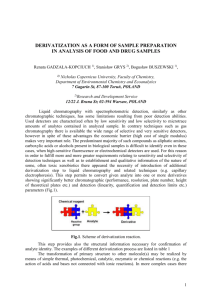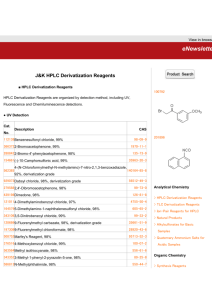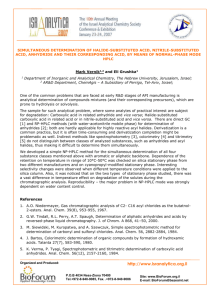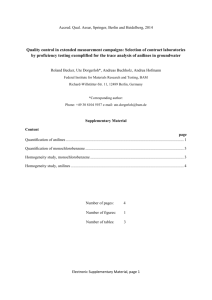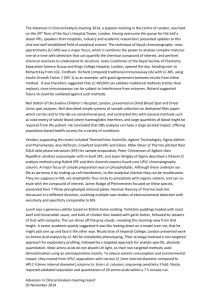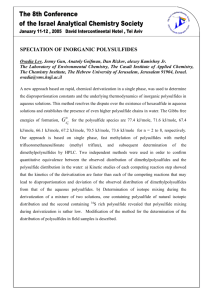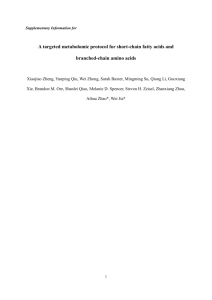GC/MS-Determination of 3,4-Dichloroaniline as
advertisement
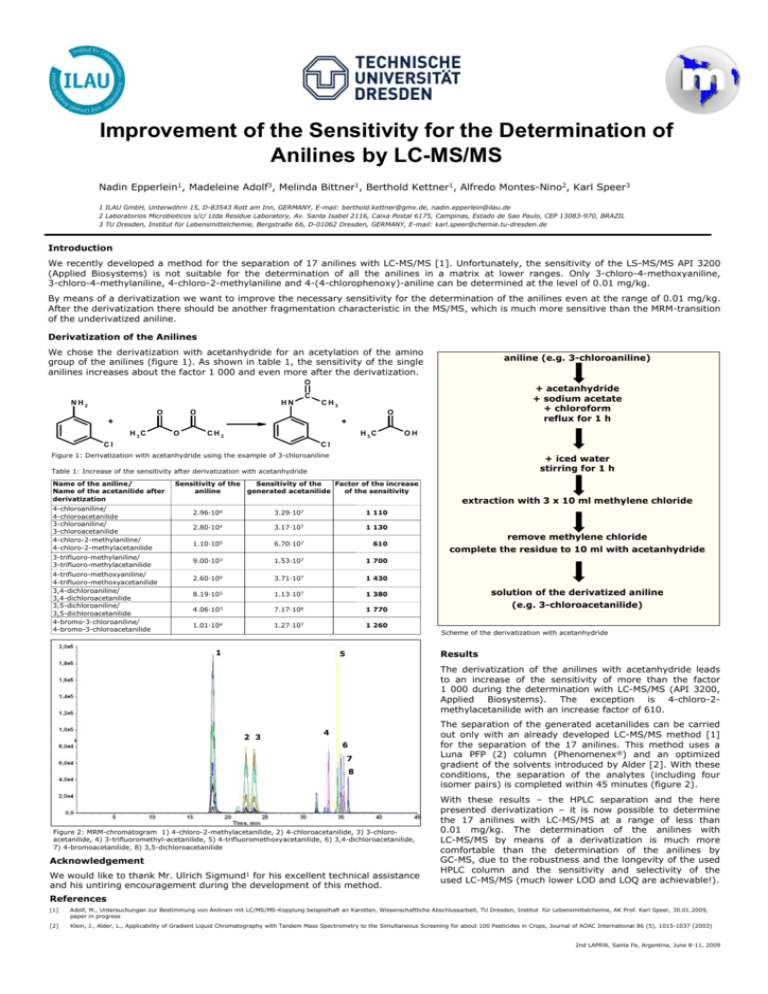
Improvement of the Sensitivity for the Determination of Anilines by LC-MS/MS Nadin Epperlein1, Madeleine Adolf3, Melinda Bittner1, Berthold Kettner1, Alfredo Montes-Nino2, Karl Speer3 1 ILAU GmbH, Unterwöhrn 15, D-83543 Rott am Inn, GERMANY, E-mail: berthold.kettner@gmx.de, nadin.epperlein@ilau.de 2 Laboratorios Microbioticos s/c/ Ltda Residue Laboratory, Av. Santa Isabel 2116, Caixa Postal 6175, Campinas, Estado de Sao Paulo, CEP 13083-970, BRAZIL 3 TU Dresden, Institut für Lebensmittelchemie, Bergstraße 66, D-01062 Dresden, GERMANY, E-mail: karl.speer@chemie.tu-dresden.de Introduction We recently developed a method for the separation of 17 anilines with LC-MS/MS [1]. Unfortunately, the sensitivity of the LS-MS/MS API 3200 (Applied Biosystems) is not suitable for the determination of all the anilines in a matrix at lower ranges. Only 3-chloro-4-methoxyaniline, 3-chloro-4-methylaniline, 4-chloro-2-methylaniline and 4-(4-chlorophenoxy)-aniline can be determined at the level of 0.01 mg/kg. By means of a derivatization we want to improve the necessary sensitivity for the determination of the anilines even at the range of 0.01 mg/kg. After the derivatization there should be another fragmentation characteristic in the MS/MS, which is much more sensitive than the MRM-transition of the underivatized aniline. Derivatization of the Anilines We chose the derivatization with acetanhydride for an acetylation of the amino group of the anilines (figure 1). As shown in table 1, the sensitivity of the single anilines increases about the factor 1 000 and even more after the derivatization. aniline (e.g. 3-chloroaniline) O + acetanhydride + sodium acetate + chloroform reflux for 1 h C NH2 HN O CH3 O O + + H3C O CH3 H3C Cl OH Cl Figure 1: Derivatization with acetanhydride using the example of 3-chloroaniline + iced water stirring for 1 h Table 1: Increase of the sensitivity after derivatization with acetanhydride Name of the aniline/ Name of the acetanilide after derivatization 4-chloroaniline/ 4-chloroacetanilide 3-chloroaniline/ 3-chloroacetanilide 4-chloro-2-methylaniline/ 4-chloro-2-methylacetanilide 3-trifluoro-methylaniline/ 3-trifluoro-methylacetanilide 4-trifluoro-methoxyaniline/ 4-trifluoro-methoxyacetanilide 3,4-dichloroaniline/ 3,4-dichloroacetanilide 3,5-dichloroaniline/ 3,5-dichloroacetanilide 4-bromo-3-chloroaniline/ 4-bromo-3-chloroacetanilide Sensitivity of the aniline Sensitivity of the Factor of the increase generated acetanilide of the sensitivity extraction with 3 x 10 ml methylene chloride 2.96·104 3.29·107 1 110 2.80·104 3.17·107 1 130 1.10·105 6.70·107 610 9.00·103 1.53·107 1 700 2.60·104 3.71·107 1 430 8.19·103 1.13·107 1 380 4.06·103 7.17·106 1 770 1.01·104 1.27·107 1 260 1 remove methylene chloride complete the residue to 10 ml with acetanhydride solution of the derivatized aniline (e.g. 3-chloroacetanilide) Scheme of the derivatization with acetanhydride Results 5 The derivatization of the anilines with acetanhydride leads to an increase of the sensitivity of more than the factor 1 000 during the determination with LC-MS/MS (API 3200, Applied Biosystems). The exception is 4-chloro-2methylacetanilide with an increase factor of 610. 2 3 4 6 7 8 Figure 2: MRM-chromatogram 1) 4-chloro-2-methylacetanilide, 2) 4-chloroacetanilide, 3) 3-chloroacetanilide, 4) 3-trifluoromethyl-acetanilide, 5) 4-trifluoromethoxyacetanilide, 6) 3,4-dichloroacetanilide, 7) 4-bromoacetanilide, 8) 3,5-dichloroacetanilide Acknowledgement We would like to thank Mr. Ulrich Sigmund1 for his excellent technical assistance and his untiring encouragement during the development of this method. The separation of the generated acetanilides can be carried out only with an already developed LC-MS/MS method [1] for the separation of the 17 anilines. This method uses a Luna PFP (2) column (Phenomenex®) and an optimized gradient of the solvents introduced by Alder [2]. With these conditions, the separation of the analytes (including four isomer pairs) is completed within 45 minutes (figure 2). With these results – the HPLC separation and the here presented derivatization – it is now possible to determine the 17 anilines with LC-MS/MS at a range of less than 0.01 mg/kg. The determination of the anilines with LC-MS/MS by means of a derivatization is much more comfortable than the determination of the anilines by GC-MS, due to the robustness and the longevity of the used HPLC column and the sensitivity and selectivity of the used LC-MS/MS (much lower LOD and LOQ are achievable!). References [1] Adolf, M., Untersuchungen zur Bestimmung von Anilinen mit LC/MS/MS-Kopplung beispielhaft an Karotten, Wissenschaftliche Abschlussarbeit, TU Dresden, Institut für Lebensmittelchemie, AK Prof. Karl Speer, 30.01.2009, paper in progress [2] Klein, J., Alder, L., Applicability of Gradient Liquid Chromatography with Tandem Mass Spectrometry to the Simultaneous Screening for about 100 Pesticides in Crops, Journal of AOAC International 86 (5), 1015-1037 (2003) 2nd LAPRW, Santa Fe, Argentina, June 8-11, 2009
